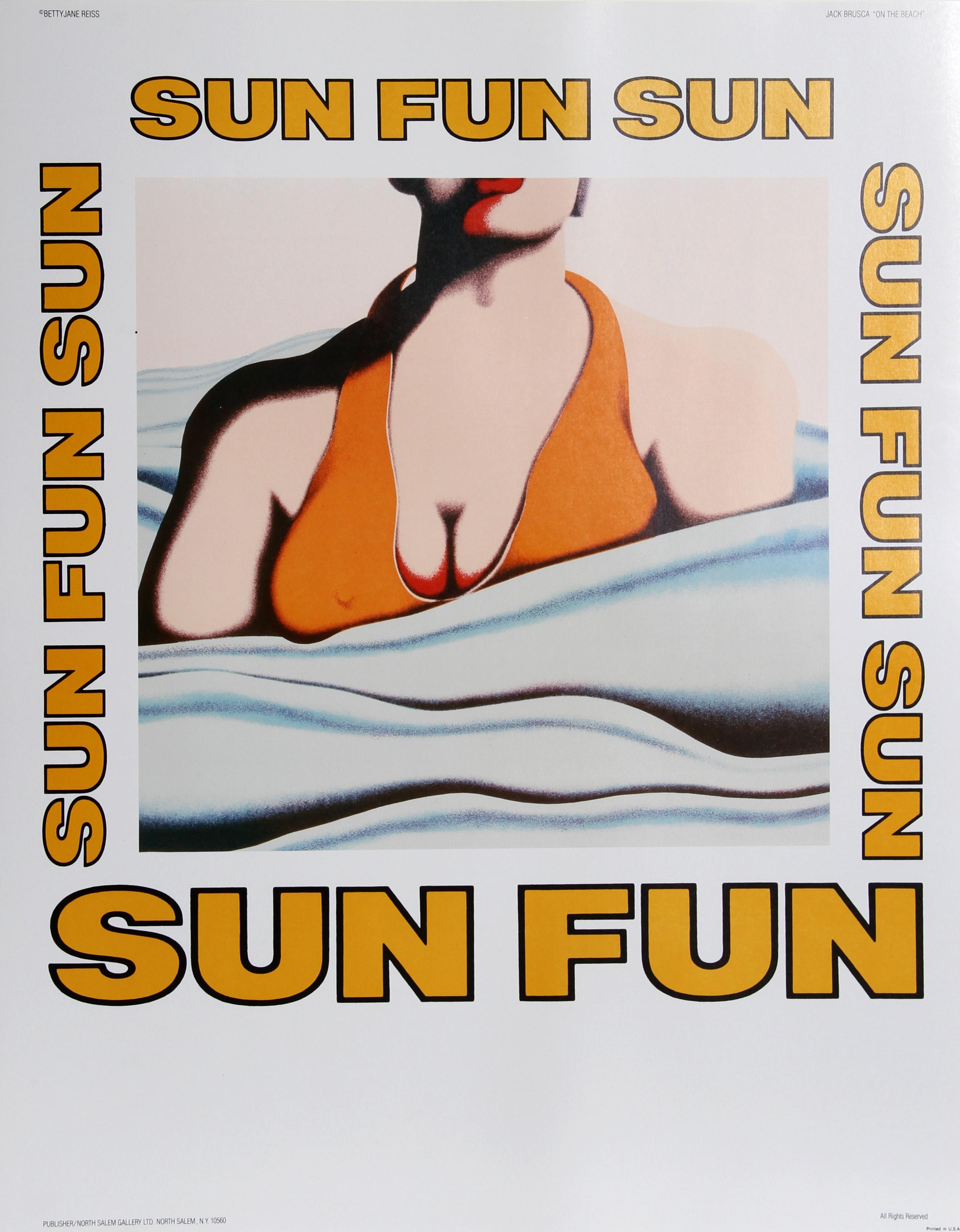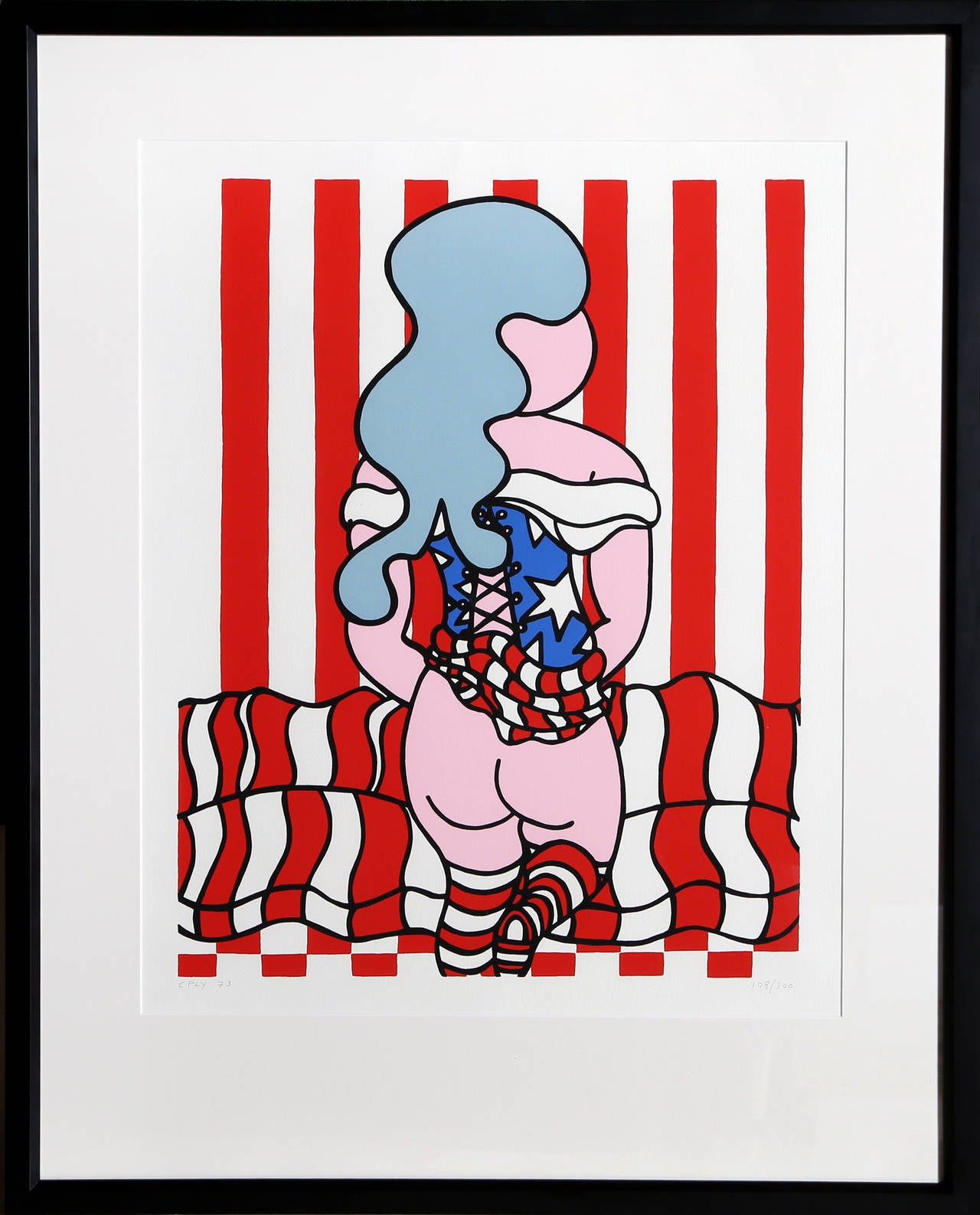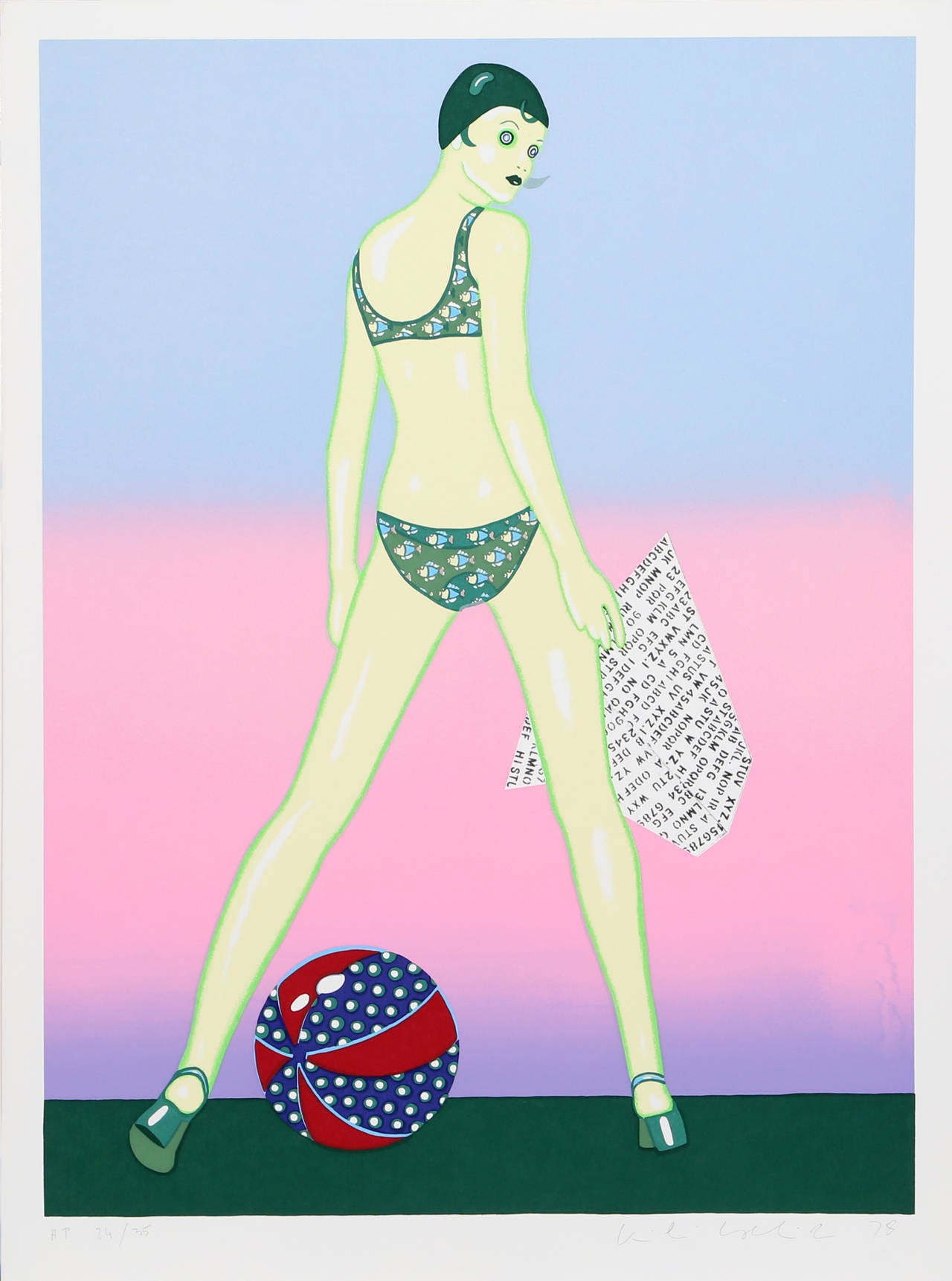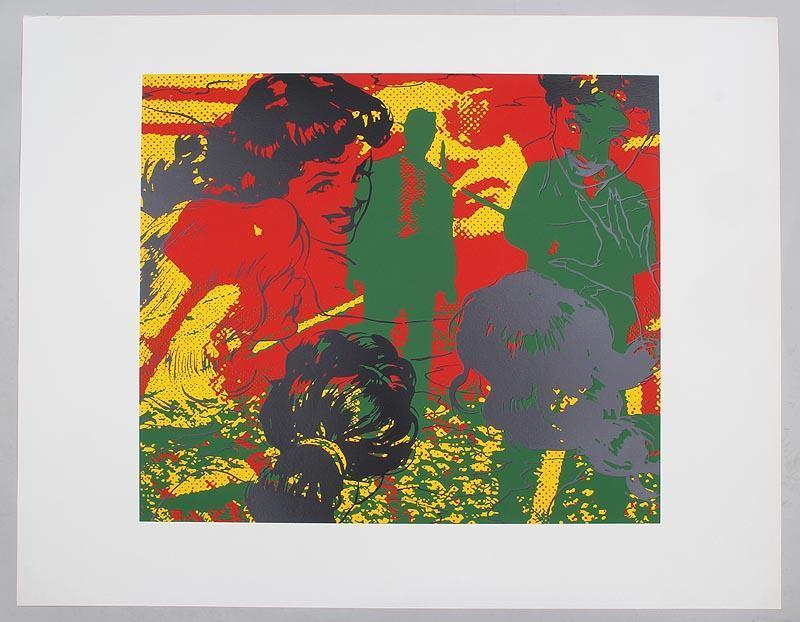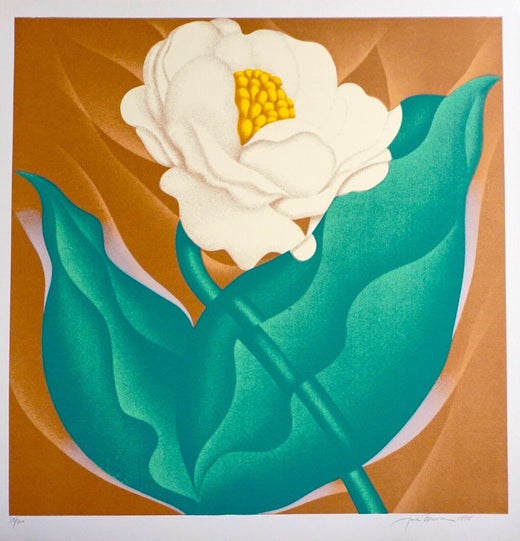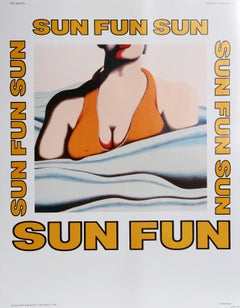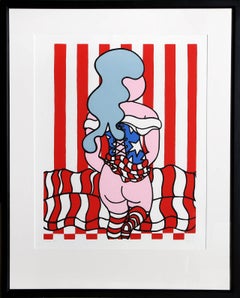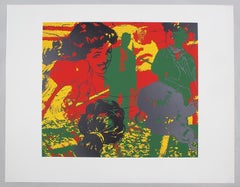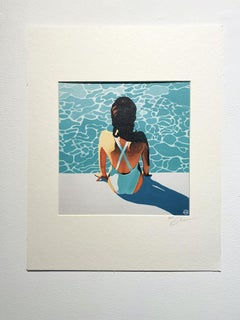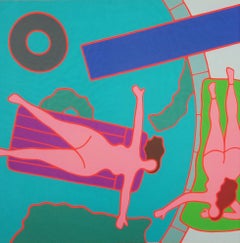Items Similar to The Beach, Signed and Framed Pop Art Screenprint by Jack Brusca
Want more images or videos?
Request additional images or videos from the seller
1 of 6
Jack BruscaThe Beach, Signed and Framed Pop Art Screenprint by Jack Brusca1979
1979
$950
£717.88
€828.98
CA$1,327.48
A$1,472.95
CHF 771.56
MX$18,062.35
NOK 9,814.03
SEK 9,264.03
DKK 6,182.22
Shipping
Retrieving quote...The 1stDibs Promise:
Authenticity Guarantee,
Money-Back Guarantee,
24-Hour Cancellation
About the Item
Artist: Jack Brusca, American (1939 - 1993)
Title: The Beach
Year: 1979
Medium: Screenprint, signed and numbered in pencil
Edition: 200, AP 30
Image Size: 23 x 23 inches
Size: 27.5 in. x 26 in. (69.85 cm x 66.04 cm)
Frame: 32 x 32 inches
- Creator:Jack Brusca (1939, American)
- Creation Year:1979
- Dimensions:Height: 32 in (81.28 cm)Width: 32 in (81.28 cm)Depth: 2 in (5.08 cm)
- Medium:
- Movement & Style:
- Period:
- Condition:
- Gallery Location:Long Island City, NY
- Reference Number:Seller: RO575971stDibs: LU46616113282
Jack Brusca
Jack Brusca (1939-1993) Jack Brusca an American artist, had his first one-man show at Galeria Bonino in New York in 1969. His ability to interpret ordinary things such as letters, numbers, and flowers, using spacial dimension and color blend give his work a theatrical-type light. He creates three-dimensional forms through a mixture of surrealism, pop, and hard-edged neo-realism. Bruscas works have been displayed throughout the United States and South America: Expo ’67 Montreal Indianapolis Museum of Art Larry Aldrich Museum – Ridgefield, CT He also designed sets and costumes for ballet. Most notably for Louis Falco’s ballet “Escarpot,” by Alvin Ailey Dance Theater in 1991.
About the Seller
4.9
Platinum Seller
Premium sellers with a 4.7+ rating and 24-hour response times
Established in 1979
1stDibs seller since 2014
3,042 sales on 1stDibs
Typical response time: 1 hour
- ShippingRetrieving quote...Shipping from: Long Island City, NY
- Return Policy
Authenticity Guarantee
In the unlikely event there’s an issue with an item’s authenticity, contact us within 1 year for a full refund. DetailsMoney-Back Guarantee
If your item is not as described, is damaged in transit, or does not arrive, contact us within 7 days for a full refund. Details24-Hour Cancellation
You have a 24-hour grace period in which to reconsider your purchase, with no questions asked.Vetted Professional Sellers
Our world-class sellers must adhere to strict standards for service and quality, maintaining the integrity of our listings.Price-Match Guarantee
If you find that a seller listed the same item for a lower price elsewhere, we’ll match it.Trusted Global Delivery
Our best-in-class carrier network provides specialized shipping options worldwide, including custom delivery.More From This Seller
View AllAt the Beach, Vintage Poster by Jack Brusca
By Jack Brusca
Located in Long Island City, NY
At the Beach
Jack Brusca, American (1939–1993)
Date: 1978
Poster
Size: 28 in. x 22 in. (71.12 cm x 55.88 cm)
Category
1970s Pop Art Figurative Prints
Materials
Offset
The Beach Group, Signed Pop Art Screenprint by Hava Raucher
By Hava Raucher
Located in Long Island City, NY
Artist: Hava Raucher
Title: The Beach Group
Year: 1980
Medium: Serigraph, signed and numbered in pencil
Edition: 300
Paper Size: 26 x 36 inches
Category
1980s Contemporary Figurative Prints
Materials
Screen
American Girl, Pop Art Screenprint by William Nelson Copley
By William Nelson Copley
Located in Long Island City, NY
An original signed silkscreen by American Pop Artist, William Copley (1919 - 1996). In a fine black contemporary frame measuring 33 x 26.5 inches.
Artist: William Copley, American (1919 - 1996)
Title: American Girl...
Category
1970s Pop Art Figurative Prints
Materials
Screen
Look Again, Pop Art Silkscreen by Kiki Kogelnik
By Kiki Kogelnik
Located in Long Island City, NY
Artist: Kiki Kogelnik, Austrian (1935 - 1997)
Title: Look Again
Year: 1979
Medium: Screenprint, signed and numbered in pencil
Edition: 200, AP 35
Image: 23.5 x 32 inches
Size: 26 x 3...
Category
1970s Pop Art Figurative Prints
Materials
Screen
Price Upon Request
Beach Ball, Pop Art Silkscreen by Kiki Kogelnik
By Kiki Kogelnik
Located in Long Island City, NY
Artist: Kiki Kogelnik, Austrian (1935 - 1997)
Title: Beach Ball
Year: 1978
Medium: Serigraph, signed and numbered in pencil
Edition: 200, AP 35
Size: 36 x 26 in. (91.44 x 66.04 cm)
Category
1970s Pop Art Figurative Prints
Materials
Screen
Price Upon Request
Spell III, Framed Pop Art Screenprint by Hunt Slonem
By Hunt Slonem
Located in Long Island City, NY
A bright and vibrant still life by pop artist Hunt Slonem. The silkscreen print is hand-signed and numbered in pencil, nicely framed.
Spell III by Hunt Slonem, American (1951)
Date:...
Category
1980s Contemporary Figurative Prints
Materials
Screen
You May Also Like
"Detente" Jerry Kearns Pop Art Silkscreen Screenprint
By Jerry Kearns
Located in Surfside, FL
"Detente" according to the artist: "These two silkscreen prints were made in 1987, edition of 5 prints. They were published by Kent Fine Art, NYC.
Signed and numbered they sell for $2,500 each". these are unsigned and unnumbered rare printers proofs. Jerry Kearns is an American visual artist who was born in 1943. Several works by the artist have been sold at auction, including 'Seven works: Exit Art The First World portfolio' sold at Phillips New York, Chelsea 'Editions' in 2010. There have been Several articles about Jerry Kearns, including 'Art in Review; Jerry Kearns' written by Holland Cotter for New York Times in 1996.
influences include Andy Warhol, Keith Haring and Roy Lichtenstein.
JERRY KEARNS SELECTED GROUP EXHIBITIONS
2007 "Kentucky Derby Benefit Party and Art Benefit Auction"
2006 “Scope MIAMI” Jack The Pelican Presents Gallery, Miami FLA.
“What a War” White Box Gallery, New York , NY. Curator Eleanor Heartney
“Gallery Artists” Modernism Gallery, San Francisco, CA.
“ WORD” Deborah Colton Gallery, Houston, TX. Curator Brandon Krall
“Hedonistic Imperative”, Deborah Colton Gallery, Houston, TX
“The Studio Visit”, EXIT ART, New York
2004 “The Print Show”, EXIT ART, New York
“25 Anniversary...
Category
1980s Portrait Prints
Materials
Screen
Beach Hotel
Located in New York, NY
Emilie Arnoux hails from Normandy, France. From a young age, she became fascinated by the ocean and the laid back lifestyle surf-culture engenders. Her work captures the divine energ...
Category
2010s Contemporary Figurative Prints
Materials
Canvas, Archival Ink
Price Upon Request
Betty (A), large hand signed screen print
By POSE
Located in Aventura, FL
Screen print in colors on had torn Coventry Rag 335 gsm paper. Hand signed lower right corner by Pose. Hand numbered 10/25 lower left. Artwork size 40 x 30 inches.
Artwork is in ...
Category
2010s Street Art Figurative Prints
Materials
Screen, Paper
$1,575 Sale Price
30% Off
Sun Therapy /// Contemporary Pop Art Nudes Swimming Pool Figurative Screenprint
By Dan May
Located in Saint Augustine, FL
Artist: Dan May (American, 1955-)
Title: "Sun Therapy"
*Signed and numbered by May in pencil lower left
Year: 1982
Medium: Original Screenprint on unbranded white wove paper
Limited edition: 1/150
Printer: the artist May himself, Oakland, CA
Publisher: the artist May himself, Oakland, CA
Sheet size: 30.88" x 29.13"
Image size: 23.13" x 23.13"
Condition: Minor wear to lower right corner. In excellent condition
Notes:
Titled and dated by May in pencil lower right. The paper is white wove, however the entire recto sheet is screenprinted with color. The margins are screenprinted in red which connect throughout the central image.
Biography:
Dan May is an American painter and printmaker born on March 11, 1955 in San Francisco, CA. Raised in aesthetic surroundings heavily influenced by his architect father, May grew up learning to view all things with an eye for design, color, and shape. At age 5, he remembers his father cutting up a book of drawings by Henri Matisse and hanging them on the walls of their home. The French master Matisse as well as Richard Diebenkorn and David Hockney are his favorite art influences. He began his first attempts at painting at age 15, and later began to experiment with printmaking, teaching himself various techniques such as woodblock printing, etching, silkscreen printing, and monoprinting.
Monoprinting soon became May's medium of choice due to its wide range of expression and spontaneity that he felt other techniques lacked. May - "With monoprinting, you can only work a piece for as a long as the paint stays wet, so the resulting print has a feeling of movement and immediacy. I also like how monoprinting allows the brush strokes to transfer a transparent light quality to the print. For me, this is a technique that bridges drawing...
Category
1980s Contemporary Nude Prints
Materials
Screen
Betty (C), large hand signed screen print
By POSE
Located in Aventura, FL
Screen print in colors on had torn Coventry Rag 335 gsm paper. Hand signed lower right corner by Pose. Hand numbered 10/25 lower left. Artwork size 40 x 30 inches.
Artwork is in ...
Category
2010s Street Art Figurative Prints
Materials
Screen, Paper
$1,575 Sale Price
30% Off
Endless Summer, pop art, landscape, swimming, still life
Located in Deddington, GB
Painstakingly hand-drawn in Jack's signature style, 'Endless Summer' immortalises long summer afternoons. This giclée print is a signed and numbered reproduction of a coloured pencil...
Category
2010s Pop Art Figurative Prints
Materials
Giclée, Paper
Read More
Romare Bearden’s Humanity Infuses His Bright, Bold Art
Through collage, painting and printmaking, the artist foregrounded Black life in America in revolutionary new ways.
Chryssa’s 1962 Neon Sculpture Was Way ahead of the Art-World Curve
By working with lettering, neon and Pop imagery, Chryssa pioneered several postmodern themes at a time when most male artists detested commercial mediums.
More Ways To Browse
Heals Fabric Vintage
Iron Cow Sculpture
Isabel Parks
Ivory Horse
Jacques Toledo
Jean Baptiste Le Prince
Jean Cocteau Pencil Drawing
Jean Jansem On Sale
Keith Haring Radiant Baby
Large Erte
Live Edge Clock
Male Nude Poster
Mexico 1968 Olympics
New Orleans Jazz Poster
Norman Rockwell Plate
Picasso Book Ceramiques
Pietro Fontana Etching
Police Mugshot
